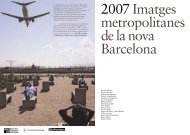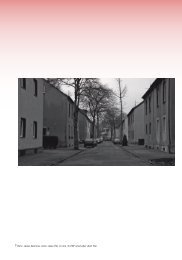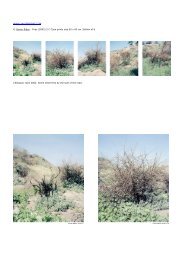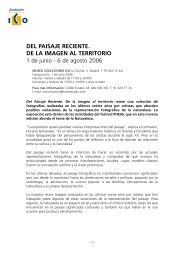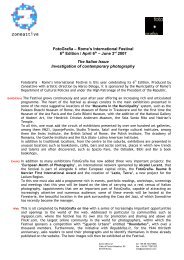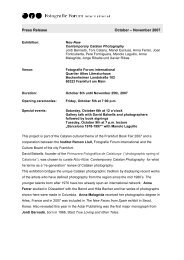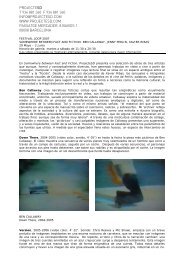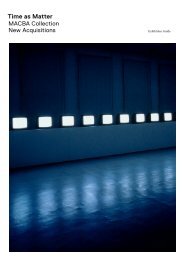Xavier Ribas Concrete Geographies [Nomads] Xavier Ribas's ...
Xavier Ribas Concrete Geographies [Nomads] Xavier Ribas's ...
Xavier Ribas Concrete Geographies [Nomads] Xavier Ribas's ...
Create successful ePaper yourself
Turn your PDF publications into a flip-book with our unique Google optimized e-Paper software.
<strong>Xavier</strong> <strong>Ribas</strong><br />
<strong>Concrete</strong> <strong>Geographies</strong> [<strong>Nomads</strong>]<br />
<strong>Xavier</strong> <strong>Ribas</strong>'s <strong>Nomads</strong> (2008) is a body of work and a subsequent publication (Bside Books, 2012) that does more<br />
than narrativise a story. The work consists of elements of an installation that includes a photographic diptych of<br />
brooding clouds, a Google Earth composite image, a text, geographical coordinates, and a grid presentation of<br />
thirty-five photographs taken of a former industrial plot on the Eastern outskirts of Barcelona. With these elements,<br />
<strong>Nomads</strong> provides a number of possible navigations, introducing ideas of how architecture serves as a mode of<br />
control and division, used by those in power against communities that are deemed unwelcome in the order of their<br />
schemes.<br />
From the text element we learn that over a period of several days in February 2004, a team of workmen with<br />
heavy machinery entered the site; their machinery put to work on the foundations, shattering and uprooting the<br />
concrete surface, until the task was complete in transforming it into an inhospitable wasteland.<br />
This was an act of premeditated violence that effectively caused the eviction of sixty families of gypsies that were<br />
then inhabiting the site. This was a violence of forced displacement. A deliberate act of architectural ruination and<br />
destruction that made it impossible for those families to remain there, leaving them with little choice, we can only<br />
guess, but to search out other redundant spaces elsewhere in the city. This act – inflicted upon architecture in<br />
effect, but upon people in practice - was not part of a plan of constructive rejuvenation, or the first step of a<br />
property development scheme that would typically, for better or worse, bring about new duplex apartments and<br />
glass-fronted businesses. No justifications were necessary back then, or have been called for since. In the nine<br />
years that have passed to this day, - visible from the windows of the commuter train that heads to the seaside<br />
town of Blanes – the site remains in its abandoned chewed-up state.<br />
In the 35 vertically-orientated black and white photographs, there are clusters of nails and upturned covers of<br />
unidentifiable books, but there is relatively little that we can align, in a classic photojournalistic sense, toward a<br />
narrative of land contestation, mechanized power, and displaced peoples. There are no shattered caravans or<br />
children's toys left behind in the calamity. The pneumatic drills and diggers, long since disappeared. In these<br />
photographs, <strong>Ribas</strong>'s camera settles on details of the broken foundations of the site; its cracks and fractures, the<br />
interruption of weeds, and the disjointed patterning of lines painted onto the surfaces that may have been bay<br />
markings or directional lines of some kind of another; a language of industrious order that is now lost and reduced<br />
to crumbs. There are materials of natural and man-made varieties that stack on top of each other and settle new<br />
boundaries. In many of these photographs, the entire frame is filled with these closely observed material<br />
dislocations and disturbances. Fragments, rather than the larger un-representable whole. It is these fragments that<br />
remain the only evidences of aggressive action taken against a widely stigmatized nomadic community.<br />
What is it that photography can do here, in a place like this, in the serene calm after the storm How can<br />
photography tell a story of struggle in this inactive and barren landscape, where the only movement is the
stubborn, slow growth of plant-life in the rubble<br />
<strong>Nomads</strong> is a work that seems to ask these questions of itself. Better still, it enacts these questions with all their<br />
implicit uncertainty and doubt, against the grain of documentary traditions. It is an embodied vision as much as a<br />
revelatory one. Beside a vision of the site itself, what we also see in <strong>Nomads</strong> is the site's impositions upon the<br />
camera-connected-body, and upon the very liberties of possible perspective.<br />
In <strong>Xavier</strong> <strong>Ribas</strong>’s photographs, the ground seems to sear up like a wall. And as viewers, we are kept tightly and<br />
inescapably bound to it, drawn to its limits. Within these confines, it’s as though the camera searches for<br />
something, some clue, some definitive remnant, or any such 'thing' that might invite a notion of history (that<br />
'spark of contingency' that Walter Benjamin once wrote of). Nothing comes. Nothing, that is, apart from the weeds<br />
and the material fractures in disturbed foundations of the site. It’s the particular kind of nothing that has a<br />
disorientating, almost suffocating effect.<br />
In those few photographs that pan upward to a broader view, we find ourselves confronted with the blank and<br />
faceless windows of overlooking industrial units. Every space that promises a breathing space is a space occupied<br />
and pre-seen. The graffiti tags on the surrounding walls make their authoritive claims upon the site in altogether<br />
different sense. The sky appears in small, inorganic slivers, as grey and as dead as the concrete on the ground. All<br />
life, apart from the weeds, seems to be in a state of evasion. Viewing this work, we become acutely aware of how<br />
architecture can act against us, upon our own bodies as spectators, but also implicitly upon the bodies that have<br />
suffered this environment at first hand.<br />
The presentation of these photographs in a grid format offers some reconstitution. A comparative and formal<br />
containment of discreet fragments, the grid format also provides the hope of awakening the muted voices of recent<br />
history and the enclaves of community. The grid structure, of course, refers to the well-known organisational<br />
strategy that exists at both ends of the speculative divide, between the urban plan and the archeological search.<br />
The satellite navigation co-ordinates and Google Earth composite images provide some specificity and exteriority to<br />
these interior planes of vision of the grid. The Google-Earth images show a rectangular shape that is the subject of<br />
these photographs; a space that is scarred in different shades of grey, looking like some kind of ancient relic<br />
against the uniform structure of rooftops and road and rail networks that define the surrounding urban fabric. This<br />
is a space that, in effect, seems to belong to another order of time, layered with our own.<br />
The day is bright, as we can see on some images. And on a day like this there are surely numerous people less<br />
than a kilometer from here, pointing their cameras to the horizon, cutting their photographic frames in neat<br />
rectangles of sea and sky, before getting on with their day. How long has it been now Three or more years since<br />
the foundations of this site were shaken, there weeds are taking over. The clouds brooding overhead are a signal<br />
that it’s going to rain, and soon the bright concrete blotches with water drops.
A photograph of the sky, taken at the end of the day, now in color, stands as a counter-vision of all that looks<br />
down upon the site with calculating eyes. As Hannah Arendt once wrote of being an emigrant: “We leave the earth<br />
and all its uncertainties behind and we cast our eyes up to the sky”<br />
© Matt Packer, 2013


![Xavier Ribas Concrete Geographies [Nomads] Xavier Ribas's ...](https://img.yumpu.com/36327519/1/500x640/xavier-ribas-concrete-geographies-nomads-xavier-ribass-.jpg)
